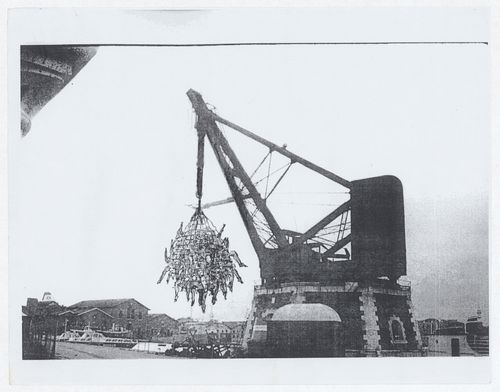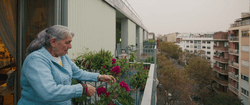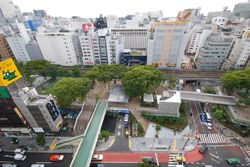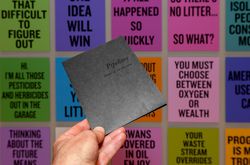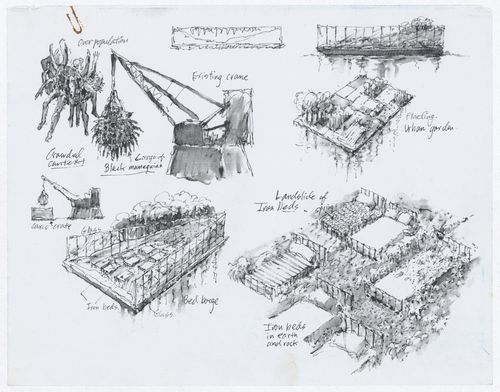ARCH286670
Description:
This item contains harmful materials including violent and racist imagery. The drawing illustrates an installation involving a crane on which a net filled with mannequins is suspended; the mannequins are painted black, in the words of the designers, to represent the impacts of oil spills on the global population. This image, however, suggests violence beyond environmental disasters.
circa 1999-2000
Drawing for an installation for the exhibition on James Wines at the Venice Biennale
Actions:
ARCH286670
Description:
This item contains harmful materials including violent and racist imagery. The drawing illustrates an installation involving a crane on which a net filled with mannequins is suspended; the mannequins are painted black, in the words of the designers, to represent the impacts of oil spills on the global population. This image, however, suggests violence beyond environmental disasters.
Où vieillir?
Où – et comment – nous voulons habiter en vieillissant? Nos quartiers, nos immeubles, nos villes sauront-ils s’adapter à nos besoins? La soirée Où vieillir? débute par la projection du documentaire Where We Grow Older (CCA, 2023, 30 min), qui explore comment l’architecture et l’urbanisme peuvent répondre aux défis du vieillissement démographique. La projection sera(...)
Théâtre Paul-Desmarais
4 décembre 2025, 18h
Où vieillir?
Actions:
Description:
Où – et comment – nous voulons habiter en vieillissant? Nos quartiers, nos immeubles, nos villes sauront-ils s’adapter à nos besoins? La soirée Où vieillir? débute par la projection du documentaire Where We Grow Older (CCA, 2023, 30 min), qui explore comment l’architecture et l’urbanisme peuvent répondre aux défis du vieillissement démographique. La projection sera(...)
Théâtre Paul-Desmarais
L’enseignement de… Tokyo
Dans sa conférence intitulée Tokyo Nine Flux, Yoshiharu Tsukamoto interprète l’espace urbain de Tokyo comme une chaîne causale de réactions à des courants, qu’il s’agisse de phénomènes naturels comme les séismes et les typhons qui exercent une menace constante sur la ville ou de l’augmentation de la population, de la circulation et des déchets. Yoshiharu Tsukamoto est(...)
Théâtre Paul-Desmarais
26 avril 2007 , 19h
L’enseignement de… Tokyo
Actions:
Description:
Dans sa conférence intitulée Tokyo Nine Flux, Yoshiharu Tsukamoto interprète l’espace urbain de Tokyo comme une chaîne causale de réactions à des courants, qu’il s’agisse de phénomènes naturels comme les séismes et les typhons qui exercent une menace constante sur la ville ou de l’augmentation de la population, de la circulation et des déchets. Yoshiharu Tsukamoto est(...)
Théâtre Paul-Desmarais
Seconde Nature
Dans le cadre de l’exposition Le temps presse, un atelier de création et réflexion est offert aux groupes du cégep et de l’université afin d’explorer les relations complexes et contradictoires que le Canada entretient avec l’environnement. En prenant la parole au nom d’entités aux intérêts multiples – écosystèmes, architecture, éthique, systèmes économiques, population(...)
26 janvier 2017 au 7 avril 2017
Seconde Nature
Actions:
Description:
Dans le cadre de l’exposition Le temps presse, un atelier de création et réflexion est offert aux groupes du cégep et de l’université afin d’explorer les relations complexes et contradictoires que le Canada entretient avec l’environnement. En prenant la parole au nom d’entités aux intérêts multiples – écosystèmes, architecture, éthique, systèmes économiques, population(...)
ARCH286690
Description:
This item contains harmful materials including violent imagery. The drawing illustrates the discrete elements of an exhibition involving several large-scale installations. One of these installations shows a crane on which a net filled with mannequins is suspended; the mannequins are soaked in oil, in the words of the designers, to represent the impacts of oil spills on the global population. This image, however, suggests violence beyond environmental disasters.
circa 1999-2000
Drawings for two installations for the exhibition on James Wines at the Venice Biennale
Actions:
ARCH286690
Description:
This item contains harmful materials including violent imagery. The drawing illustrates the discrete elements of an exhibition involving several large-scale installations. One of these installations shows a crane on which a net filled with mannequins is suspended; the mannequins are soaked in oil, in the words of the designers, to represent the impacts of oil spills on the global population. This image, however, suggests violence beyond environmental disasters.
Projet
AP164.S1.1997.D12
Description:
The subseries documents the show-event base “Fabricaciones / Fabrications,” held at the Museu d'Art Contemporani de Barcelona (MACBA) (February 10th to April 20th, 1998). The firm identified this project as number 110. “Fabrications was an innovative exhibition on architecture conceived and produced jointly by MACBA, MoMA, the Wexner Center for the Arts and the San Francisco Museum of Modern Art. The exhibition presented sixteen life-size architectural interventions, four at each participating center, each produced by a team of architects who explored tectonic issues in a broad sense. The four installations presented at Plaça dels Àngels – the square in front of the MACBA building – explored and modified the surfaces that defined this public space. Vicente Gualla (Barcelona) created an intervention on the façade opposite the Museum, which drew attention to the occupation and the population density that was absent from the buildings in the square. Abalos & Herreros (Madrid) acted upon the façade of the MACBA building itself, cladding and decorating its most monumental elements: the tower and the balcony. Riegler Riewe (Graz) worked with the whole of the square, inscribing a broken horizontal line along the perimeter of the public space. Finally, MVRDV (Rotterdam) acted upon the paving through an evocation of a series of different kinds of sports grounds.” (MACBA website) Documenting the exhibition are design development drawings, correspondence, project descriptions, budgets, notes, and reference, graphic and photographic materials.
1996-2002
MACBA [Museu d'Art Contemporani de Barcelona] (1997)
Actions:
AP164.S1.1997.D12
Description:
The subseries documents the show-event base “Fabricaciones / Fabrications,” held at the Museu d'Art Contemporani de Barcelona (MACBA) (February 10th to April 20th, 1998). The firm identified this project as number 110. “Fabrications was an innovative exhibition on architecture conceived and produced jointly by MACBA, MoMA, the Wexner Center for the Arts and the San Francisco Museum of Modern Art. The exhibition presented sixteen life-size architectural interventions, four at each participating center, each produced by a team of architects who explored tectonic issues in a broad sense. The four installations presented at Plaça dels Àngels – the square in front of the MACBA building – explored and modified the surfaces that defined this public space. Vicente Gualla (Barcelona) created an intervention on the façade opposite the Museum, which drew attention to the occupation and the population density that was absent from the buildings in the square. Abalos & Herreros (Madrid) acted upon the façade of the MACBA building itself, cladding and decorating its most monumental elements: the tower and the balcony. Riegler Riewe (Graz) worked with the whole of the square, inscribing a broken horizontal line along the perimeter of the public space. Finally, MVRDV (Rotterdam) acted upon the paving through an evocation of a series of different kinds of sports grounds.” (MACBA website) Documenting the exhibition are design development drawings, correspondence, project descriptions, budgets, notes, and reference, graphic and photographic materials.
Project
1996-2002
ARCH286669
Description:
This item contains harmful materials including violent and racist imagery. The drawing illustrates the discrete elements of an exhibition involving several large-scale installations. One of these installations shows a crane on which a net filled with mannequins is suspended; the mannequins are painted black, in the words of the designers, to represent the impacts of oil spills on the global population. This image, however, suggests violence beyond environmental disasters.
circa 1999-2000
Drawing for the exhibition on James Wines at the Venice Biennale
Actions:
ARCH286669
Description:
This item contains harmful materials including violent and racist imagery. The drawing illustrates the discrete elements of an exhibition involving several large-scale installations. One of these installations shows a crane on which a net filled with mannequins is suspended; the mannequins are painted black, in the words of the designers, to represent the impacts of oil spills on the global population. This image, however, suggests violence beyond environmental disasters.
Meetings and News Releases
ARCH203210
Description:
Publications et extraits de publications dans lesquels fut publié le communiqué de presse invitant la population à participer à la levée de fonds (1966-1967); texte de Przygoda sur l'histoire des Polonais adressé au Congrès Canadien polonais (1966); brouillon du texte de la circulaire annoté; correspondance (1966); minutes du comité du monument (1966); coupures de journaux et publications (1966); "mailing list for news releases, 1966"; communiqué de presse (1966); notes manuscrites.
avril 1966 à juin 1967
Meetings and News Releases
Actions:
ARCH203210
Description:
Publications et extraits de publications dans lesquels fut publié le communiqué de presse invitant la population à participer à la levée de fonds (1966-1967); texte de Przygoda sur l'histoire des Polonais adressé au Congrès Canadien polonais (1966); brouillon du texte de la circulaire annoté; correspondance (1966); minutes du comité du monument (1966); coupures de journaux et publications (1966); "mailing list for news releases, 1966"; communiqué de presse (1966); notes manuscrites.
avril 1966 à juin 1967
documents textuels
AP206.S2.066
Description:
File was originally housed in a binder along with content arranged in AP206.S2.065, AP206.S2.067 and AP206.S2.068. This file includes the following papers: "The Politics of Urban Redevelopment: A Study of Old Delhi by Ajay K. Mehra," book review "Environmental Management of Mining Operations Human Settlements and Rehabilitation of Population," 1986 "Reminiscences of Education in Pre-independence India," 1997 "The Pedestrian, the Rickshaw and the Motor Vehicle" "Chandigarh: As I see it" "Conservation is our Future" "Sikh Architecture by PS Arshi," review "The Aftermath of Vistara" "Random Thoughts on Architectural Education"
1985-1997
Published and unpublished papers (folder 2 of 4)
Actions:
AP206.S2.066
Description:
File was originally housed in a binder along with content arranged in AP206.S2.065, AP206.S2.067 and AP206.S2.068. This file includes the following papers: "The Politics of Urban Redevelopment: A Study of Old Delhi by Ajay K. Mehra," book review "Environmental Management of Mining Operations Human Settlements and Rehabilitation of Population," 1986 "Reminiscences of Education in Pre-independence India," 1997 "The Pedestrian, the Rickshaw and the Motor Vehicle" "Chandigarh: As I see it" "Conservation is our Future" "Sikh Architecture by PS Arshi," review "The Aftermath of Vistara" "Random Thoughts on Architectural Education"
documents textuels
1985-1997
Projet
Casal das Figueiras, Setubal
CD034.S1.1975.PR02
Description:
This project series contains seven reproductions of drawings displayed in the exhibit to document the Casal das Figueiras neighbourhood, in Setúbal, south of Lisbon, Portugal. The exhibit text explained that: ... the Setúbal port-city experienced the political vibrations of the revolutionary year with great intensity. The Casal das Figueiras neighbourhood was designed for a fishing community living in a difficult area to build on due to its steep incline. The challenge that the project architect Gonçalo Byrne faced was to maintain the structure of single-family housing with the outhouse or courtyard, the typology that the local populations requested, while making a large urban gesture. The proposal was based on two types of housing (the square and rectangular plans). This overcame the problem of the 36 percent slope in an architecturally striking manner, while it also managed to fulfil the major requirement inherent in any SAAL operation of minimizing costs. (The SAAL Process, Housing in Portugal 1974–76) Gonçalo Byrne worked for SAAL/Lisbon and Central South with Ana Ferreira Rebocho, Berta Sá Caetano and the residents' association Casal das Figueiras, that was founded on October 30th, 1975. The project included 420 dwellings. The operation began in July 1975 , with a construction date in October 1976. This project series contains reproductions of implementation plans and design development drawings. The original drawings were produced in 1978-1979 and were reproduced in 2015 for the exhibit.
1978-1979
Casal das Figueiras, Setubal
Actions:
CD034.S1.1975.PR02
Description:
This project series contains seven reproductions of drawings displayed in the exhibit to document the Casal das Figueiras neighbourhood, in Setúbal, south of Lisbon, Portugal. The exhibit text explained that: ... the Setúbal port-city experienced the political vibrations of the revolutionary year with great intensity. The Casal das Figueiras neighbourhood was designed for a fishing community living in a difficult area to build on due to its steep incline. The challenge that the project architect Gonçalo Byrne faced was to maintain the structure of single-family housing with the outhouse or courtyard, the typology that the local populations requested, while making a large urban gesture. The proposal was based on two types of housing (the square and rectangular plans). This overcame the problem of the 36 percent slope in an architecturally striking manner, while it also managed to fulfil the major requirement inherent in any SAAL operation of minimizing costs. (The SAAL Process, Housing in Portugal 1974–76) Gonçalo Byrne worked for SAAL/Lisbon and Central South with Ana Ferreira Rebocho, Berta Sá Caetano and the residents' association Casal das Figueiras, that was founded on October 30th, 1975. The project included 420 dwellings. The operation began in July 1975 , with a construction date in October 1976. This project series contains reproductions of implementation plans and design development drawings. The original drawings were produced in 1978-1979 and were reproduced in 2015 for the exhibit.
Project
1978-1979
